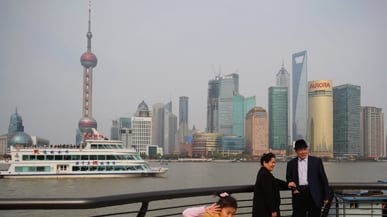Our intrepid business traveler finds herself in China’s largest city, where surprises—many delightful, some not—lurk around every corner.
The Expo 2010 World’s Fair recently finished its record-breaking run in Shanghai with elaborate pavilions representing 200 countries that highlight what it might be like to experience Saudi Arabia, Germany, or even, say, China. This modern marvel drew in excess of 500,000 people per day and in total shuffled 70 million people through the six-month-long exhibition. Welcome to China.

Shanghai is the most populous city in the world’s most populous country, and often dubbed the birthplace of modern China with such milestones as the first car, the first train tracks, and the all-important first sewage system. Shang (above) hai (sea) is translated to ‘Upper Sea,’ and this magnificent place remains the most invigorating and luminous city in the People’s Republic of China. Often touted as the world’s fastest growing economy, it’s a destination to be reckoned with. There are 20+ million people in Shanghai, marvellous skyscrapers (notably the Shanghai World Financial Center, which standing at 1,614 feet tall makes it the tallest skyscraper in China and the third tallest in the world), an infamous river, knock-off everything, ivory-skinned models, ample poverty, newfound wealth, mind-blowing artisanship and cuisine that easily rivals any culinary mecca. Shanghai’s people are ambitious, fast and plentiful. The city itself evolves at the speed of light. An illustration at the Oriental Pearl Tower, which incidentally stands at a whopping 1,535 feet tall, chronicles the city’s transformation for all to experience and is a GWS must-see during any maiden voyage.
A visit to China takes real reflection during and afterward to reconcile how you feel about it. If I’m honest, and after many trips and a stint living in Hong Kong, I still don’t know how I do. How can a place provoke simultaneous feelings of fear and intrigue, beauty and filth, innovation and imitation? Travel in the PRC will yield the most exciting and uncomfortable emotions; be sure not to miss a few creature comforts. You’ll need them.
Stay
Hotels here are some of the most impressive on the planet. Think big, sleek, and lavish. Deciding where to stay depends on what you intend to do. Business people are inevitably spending their days in Pudong’s financial district across the river from the Bund. With easy access to the WFC mall and its requisite amenities and killer views, there is a standout choice: The Ritz-Carlton, Shanghai Pudong. This newly minted stunner, from what I can tell, is without flaw. 285 rooms, four gorgeous restaurants all with incredible private dining areas, with the GWS favorite being the 18-table round top in Jin Yuan. And for the treat to end all treats head to the swanky 58th floor lounge Flair (which was designed by Japanese firm Super Potato infusing a real Japanese, sorry, flair to it). Convincing me there is a more remarkable view will not be easy. Rooms from $345.
As a regular tourist—a.k.a. someone not trying to cash in on China—stay on the Bund. Is it touristy? Yes. Loud? You bet. Crowded? Don’t even get me started. But it is magical. Think of it as a jam-packed urban beach at the height of the season. Bizarre party boats with gaudy lighting run up and down the Huangpu River, people strut up and down the promenade like a boardwalk, hotels and fancy restaurants lure in ‘gwailos’ like GWS, and a few streets over (in any direction) is a whole other world happening. On the Bund, two big brands are duking it out. The newly re-opened Peace Hotel is a Gothic grand dame that came to prominence in the late ‘20s and has had a star-studded run over the past eight decades, first as the Cathay Hotel and as the Peace since 1956. She has had a three-year, multi-million dollar facelift and is nearly there. It does have a few kinks, but what it lacks in staffing it makes up for in history. The spa isn’t yet open and the jazz lounge has men thumbing away in a throwback to the revolution. To see is to believe. 270 rooms, over-priced from US $550 per night.
Up the street slightly, you’ll find the pristine Peninsula. Your eyes will be tricked into thinking this is an old structure made to look new, but think again—it’s a fugazi, the only hotel built on the Bund in 60 years. Apparently new is the new old. With marble archways, a sea-swept spa and lacquered restaurants, this place sparkles. It’s still a splurge, but with luck the feeling of perfection won’t end until your credit card statement arrives. 235 rooms, with arguably the city’s best restaurants: Yi Long, which boasts Shanghai’s first Michelin-starred Chef, Chi Keung Tang, and Sir Elly’s as the perfect deco indulgence. Rooms from $375.
For a tremendous boutique option, consider The PuLi, just at the beginning of the French Concession. With free breakfast, scrummy in-room Nespresso, and rates below $200 if you book well enough in advance, this spacious “urban resort” removes a bit of the Disney feel from your stay. 193 rooms and 36 suites.
Eat
Before I kid anyone, I am not about to recommend street vendors or secret dumpling shops. I apologize to those readers who crave this; it is not my thing, especially not in this country. Fodor’s or Lonely Planet are ace at this and I happily point you in their direction. In other words, if you’d fancy a well-sauced something, killer carbs, or a sumptuous cocktail, read on.
Mr & Mrs Bund comes recommended and it feels like you’re walking into a scene from Alice in Wonderland. Huge tables and chairs and glossy banquets line this 6th floor ditty. Then the menu arrives. It is a dead-ringer for The Cheesecake Factory with endless pages of weirdly-paired choices from Vichysoisse to Pad Thai. Huh? I was nervous, considering I brought three colleagues with me. Then the food arrived. Wow. The flavors of pates and juicy chicken and beef adorned our tabletop. All conversation stopped and pleasant groans followed. This is perfect for dinner parties with three or more; the room and the plates are too large for pairs. Be sure to book. Sumptuous cocktails with a fun outdoor deck to take in the sights. Mains from $18.
Off the beaten path lies The Purple Onion, tucked away down a side street. This David Laris Mediterranean winner is like Aspen in downtown Shanghai. Finding it is half the battle – tell your driver it is off Changshu Road and be sure to have a map. Inside you’ll be pleasantly met with a cosy contemporary space that yields sublime cocktails (skip their namesake martini—too sweet—and instead go for the Loose Goose or Basilica) and food that will be hard to beat in the PRC. You’ll swoon for the grazing and starters menus. The roasted portobello and their pizzas are worth the trip alone. Handsome looking people and rather accessible prices; both left us happily sated. Reservations necessary. Dishes from $9 USD
And for dumplings, as already referenced, GWS doesn’t stray into the vast unknown. For the sure thing, try Din Tai Fung.
This is a Taiwanese dumpling house with outposts the world over and origins dating back to the ‘20s (and the fan-base to prove it.) Their sumptuous pork dumplings and braised beef noodles are not to be missed. Six Shanghai locations, including Xin Tian Di (below).
Do
The circus of our youth has transformed itself into joint-defying theatrical acrobatics. Long gone are the bike-riding bears and creepy clowns; enter motorcycles in cages, dance-fighting dudes, and rings of fire. The Shanghai Acrobatic Troupe feels like the birthplace of this craft. Simpler than Cirque de Soleil, and equally wow-worthy, these talented folks perform seven nights a week and are not to be missed. Any concierge can arrange tickets, even on the day. A GWS tip is to arrange for a driver in either direction; cabs are sparse in this area.
Liuli China Museum has reopened with a Buddhas Retrospective from 1987-2010 that includes Chinese Ink and wash paintings. This funky urban museum is a cultural amuse bouche in the heart of a smelly but ultimately rewarding shopping neighborhood on Xinle Branch Street. This is a local stretch, so don’t expect a lot of English spoken unless you stumble into the über-trendy shop Hello Panda. This genius hipster shop is awash with angry and often ironic panda regalia and a worthy—or, dare I say, welcome—antagonist to its sugary sweet Asian alternative Hello Kitty. GWS couldn’t resist a bedazzled tee.
Shanghai shopping spans the spectrum: at one end the knock-off markets that require steely patience to get to the secret rooms for the “good stuff,” to the true glamour brands of Cartier, Bentley, and Chanel to be found in any metropolis, and then as if straight from Goldilocks, the middle ground that feels just right. Enter Xin Tian Di, a sweet brick-lined shopping and culture area that feels eerily similar to Boston’s Faneuil Hall or Chicago’s Navy Pier (sans the lake.) Grab a pal and head to Xin Tian Di for a leisurely afternoon stroll, lunch, a flick, or to stumble upon a few wares.
Avoid
One of the more highly rated fancy restaurants in town is Jean Georges. Skip this over-priced, over-sauced, and under-lit experience. It is average at best and hawked like it is the ultimate indulgence. You are more interesting than this. Trust me.
Yu Garden (short for Yuyuan Garden) dates back to 1559 and is rich with history from the Ming Dynasty, the Opium Wars, and the Taiping Rebellion. However, a visit here feels akin to a trip to Times Square on New Year’s Eve: a horrendous idea. Hordes of people adorn every square inch of this area—from the outside koi ponds to the inside tours of varying halls and relics—and it simply isn’t worth it. Every tour guide starts here, so do yourself a favor and just read about it.
Jolie Hunt travels on her own dime for more than 50% of the year. Her recommendations are aimed at business travelers who are short on time but not on taste. She is the global head of public relations for Thomson Reuters, appointed April 2008. She lives between New York and London.






